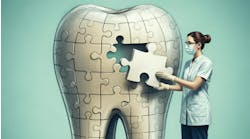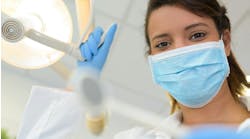by William G. Dickerson, DDS
Through a series of questions and answers, a practitioner with expertise in neuromuscular occlusion explains why this field contains information every dentist should know something about.
In an effort to inspire dentists not to give up hope and to try to achieve the success they have always wanted, I have been asked to do a series of interviews with successful individuals. The goal is to give some insight into the thinking of those who have persevered and find out how and why they are successful. This interview is with Dr. James F. Garry, a general dentist practicing in Fullerton, Calif.
Dr. Dickerson: How did you develop a practice that is so different from the average practice? Why did you do it and have you found it difficult?
Dr. Garry: The difficulty in developing a practice that is so different from the average is the unjust criticism by fellow colleagues with little or no clinical experience in the application of the technology. However, I can honestly say that my difficulties have been minimal compared to the tremendous clinical success I have had in treating symptomatic and asymptomatic patients to an optimal neuromuscular position. My practice has exploded with patients in pain from all over the world - patients who have been treated unsuccessfully for orofacial pain, or who have had full-mouth reconstruction that has failed.
Dr. Dickerson: I'm sure you had no idea what you were getting into when you went in this direction. What has been the most surprising thing in your professional journey?
Dr. Garry: First, learning that I could document optimal craniomandibular relationships utilizing biomedical electronic instrumentation. Imagine having the ability to relax muscles of mastication, verify relaxation with electromyographic recordings, and record, with precision, the physiologic rest position from which occlusion can be established along a myotrajectory path of closure 1 to 1.5 mm from physiologic rest.
Second, the rapidity of pain resolution and the stability of occlusion.
Third, the resolution of medical symptoms that are not recognized by most dentists as often arising from a craniomandibular disorder, such as otalgia, subjective hearing loss, fullness in the ear, retro-orbital pain, vertigo, tinnitus, cervicalgia, migraine-type headaches, tearing of the ears, etc. When medical treatment for these symptoms has failed, neuromuscular alignment of the mandible to the cranium is often successful.
Dr. Dickerson: Who or what has been the most inspirational in your professional career?
Dr. Garry: The most inspirational colleague I have ever had the honor of knowing was Dr. Bernard Jankelson. He is the father of neuromuscular dentistry, as well as a teacher, inventor, and practitioner of prosthodontics. He pioneered computerized diagnostics as an aid in the diagnosis and treatment of craniomandibular disorders. He taught me that if you could measure it, it is a fact, and, if you can't measure it, it is an opinion.
He stood alone among his fellow colleagues for years, professing the need for dentists to become physiologists of the head and neck. He utilized surface electromyographic recordings (sEMG) to document muscle activity at rest and in function; utilized ultra-low-frequency TENS to facilitate relaxation of all masticatory muscles; developed jaw tracking instrumentation to measure, analyze, and display mandibular movement in multiple dimensions; and developed sonography to record joint sounds. These are the same technologies used for comparable purposes in medical diagnosis and treatment. The measurement devices have the ADA scientific council seal of acceptance and FDA regulatory clearance.
Dr. Dickerson: Did you immediately use neuromuscular techniques when you began your clinical practice?
Dr. Garry: When I graduated from the University of Southern California in 1954, there was no neuromuscular technology. In fact, computers had not been invented. I was taught to push the mandible to the most retruded position from which unstrained lateral movement could be made. This propelled me into pedodontics for 20 years to avoid retruding the mandible. Twenty-seven years ago, my sister developed severe head and neck pain resulting from equilibration of her teeth by a good friend of mine, and was treated with several splints. His inability to relieve her pain forced me to seek another mode of treatment.
This changed my life.
I met Dr. Jankelson, who insisted I take his course on neuromuscular occlusion. I told him that I was a pedodontist and had no need to learn neuromuscular dentistry. He asked me if I wanted to be a "mechanic" or a "physiologist of the head and neck" for the rest of my life. What could I say? So my staff and I sat through one week of the most exciting, informative dental course I had ever taken. Thirty dentists and their staff members were in attendance; 15 of those dentists had severe TMJ pain and had been treated previously without success. Dr. Jankelson smiled and said, "I will have each of you out of pain by the end of this week." I thought to myself, "I'm in another voodoo course!"
Dr. Jankelson performed a comprehensive history, evaluated radiographs supplied by the dentists present, and proceeded to use biomedical technology as an aid to his diagnosis and treatment. By the end of the week, every dentist treated was asymptomatic, as Dr. Jankelson had promised. So, 27 years ago, I went from a pedodontist to a general practitioner with an expertise in neuromuscular occlusion. My bonus was that I had my sister asymptomatic within 24 hours.
Dr. Dickerson: Many conventional occlusionists believe that you cannot open the vertical of a patient. Some have stated that, when restoring to the proper vertical by opening the existing bite, it will always return to its original vertical. I know you have been doing this for a very long time. Is that a problem with these cases that require opening the vertical?
Dr. Garry: It is extremely important to understand that patients continually lose vertical over the years as a result of attrition. Many adversaries state that vertical dimension should never be altered. I have more than 4,000 patients over a period of 27 years whom I have increased vertical to a neuromuscular position and, to my knowledge as of this interview, have not had a single relapse. To the delight of my patients, the cosmetic improvement is immediate.
The neuromuscular dentist uses known physiologic phenomena to better deliver an occlusal result that is optimally synergistic for teeth, TMJs, and masticatory muscles. Masticatory muscle activity is recorded by sEMG prior to relaxation. Relaxation is achieved utilizing ultra-low-frequency stimulation and verified by sEMG. Relaxation and decompression are elemental to all therapeutic paradigms for treatment of the musculoskeletal system.
Dr. Dickerson: Since the physiological rest position is the ideal place to start a restorative process, what is the best way to determine that position, in your opinion?
Dr. Garry: The best way to establish a physiological rest position is to relax the muscles of mastication with ultra-low-frequency TENS, verify relaxation with sEMG recordings, and electronically track the change of mandibular posture from a pathologic position to a physiologic rest position. This position is repeatable and consistent.
Dr. Dickerson: So, once the physiological rest position is acquired, how does the dentist determine where the occlusion should be built?
Dr. Garry: As I stated earlier in this interview, occlusion should be built 1 to 1.5 mm from the physiologic rest position along the myotrajectory. The myotrajectory is established by pulsing a patient with a low-frequency TENS unit from physiologic rest position upward 1 to 1.5 mm. The TENS unit has two purposes - to relax the entire masticatory musculature verified by sEMG and to propel the mandible through space along a myotrajectory path.
Dr. Dickerson: What do you say to those who are absolutely sure the bimanual-manipulation technique of CR position is the right position? Can you say that about myocentric?
Dr. Garry: To those dentists who employ bimanual manipulation to establish CR, I plead with you to verify what happens to masticatory muscles with sEMG recordings. You must not induce muscle tension when manipulating the mandible. Remember that a pathologic position does not always result in clinical TMJ symptoms. We can be in an accommodative pathologic position without clinical symptoms.
A few years ago, I was lecturing at White Memorial Hospital in Los Angeles and made the statement that 80 percent of all head and neck pain was muscular. At the end of my lecture, an elderly, short woman came to the podium and stated that she had enjoyed my lecture; however, my percentage of muscle pain was not correct and stated that it should be at least 90 percent. I asked her if she was a physician and she confirmed that she was. I asked her what her name was and she smiled and said, "My name is Janet Travell." I told her if I had known she was in the audience, I would have acknowledged her as she has been my idol since I read her textbook titled "Myofascial Pain and Dysfunction - The Trigger Point Manual." She was President Kennedy's personal physician and an adorable human being. We became close friends over the years and shared our experiences.
I tell you this relationship so you can understand why I am vehement on documentation. Know what you are doing to muscles when you manipulate the mandible. Don't leave a patient in an accommodative pathologic position.
Dr. Dickerson: If you could give advice to a young dentist starting out on his or her journey, knowing what you know after all these years of practice, what would it be?
Dr. Garry: Don't be satisfied with the status quo. Continue to improve your clinical skills. Investigate new technologies, and don't condemn modalities that are unfamiliar to you. Dentistry can be exciting and rewarding. I have been in dentistry for 50 years; I entered USC in 1950 and I am still practicing full-time. Dentistry is my hobby; make it your hobby. Why should you or I retire?
Dr. Dickerson: Thank you for your insights on this controversial subject. I appreciate you not ever giving up against all that was stacked against you. Nothing has excited me in dentistry, not even esthetics, as much as neuromuscular dentistry. It has changed my life and the lives of hundreds of dentists who have come through our occlusion programs. Thanks for being one of the great pioneers in this area.





